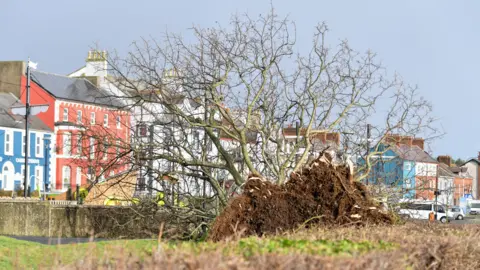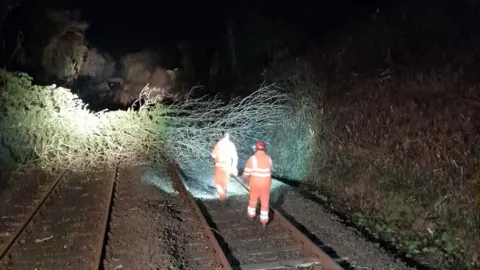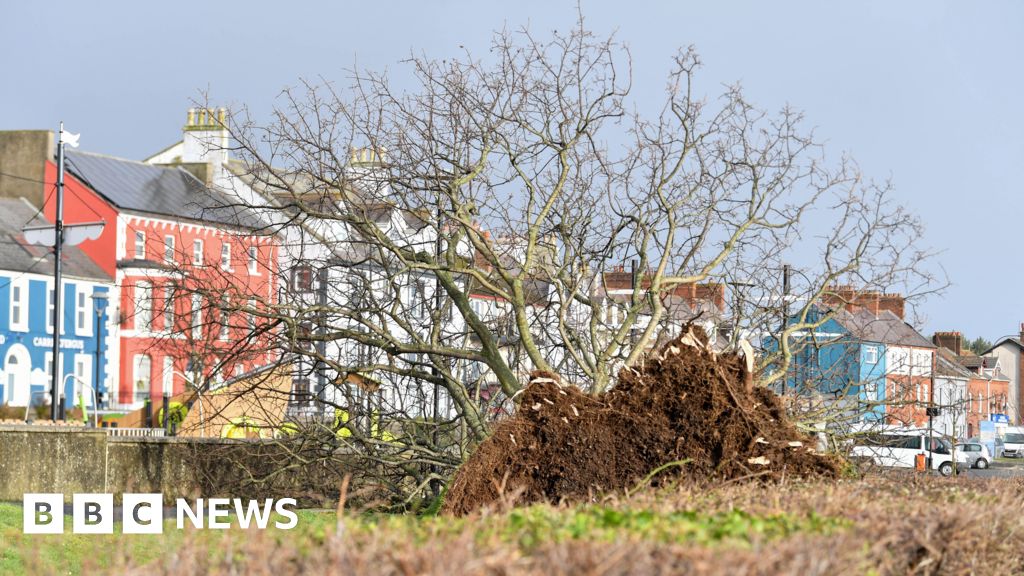 Pacemaker
PacemakerThe clear-up operation is continuing after Storm Éowyn caused chaos across Northern Ireland on Friday.
It brought winds of more than 90mph and, at the peak, left 30% of homes and businesses without power.
About 189,000 properties were still without electricity as of 06:00 GMT on Saturday.
Northern Ireland saw the highest gust in 27 years, with 92.2mph (148km/h) recorded at Killowen in County Down.
The rare red weather warning, which came in on Friday morning, ended at 14:00 GMT.
Along with further wind warnings until midnight on Friday, a snow and ice warning was issued across Northern Ireland from 19:00 on Friday until 10:00 on Saturday.
Before the storm hit, the Met Office said there was a danger to life and political leaders urged people to stay at home.
As the strong winds swept across the island of Ireland there was damage to buildings and trees fell down, blocking roads and damaging homes.
Schools, colleges, universities and businesses closed and most hospital appointments were cancelled as the storm caused significant disruption.
Rail and bus services and flights were also affected.
 Pacemaker
PacemakerIn the Republic of Ireland, where a red warning was also in place, about 540,000 properties are still without power, down from a peak of 768,000 earlier on Friday.
More than 138,000 properties are without water in the Republic as Storm Éowyn causes chaos across the island.
A man died after a tree fell on the car he was driving in Raphoe, County Donegal.
A status yellow snow-ice warning is in place in Donegal until 09:00 local time on Saturday.
ESB Networks described the storm as “record-breaking” and said it had never experienced so many power cuts in the country before with any extreme weather event.
Provisional new records for wind speed were recorded in the Republic Ireland, with hurricane-force sustained winds of 85 mph (137 km/h) at Mace Head, County Galway.
Public transport
 Translink
TranslinkTranslink said engineers worked overnight into Saturday to clear railway lines, with specialist teams carrying out safety checks.
Metro, Glider and Ulsterbus services returned on Friday with some diversions in place due ongoing road closures due to the storm.
However, Translink said rail lines will be opened gradually due to “extensive damage” across the network.
“There has been unprecedented damage with dozens of incidents across the rail network with the storm bringing trees down on tracks and damage to barriers and other structures,” a spokesperson said in a statement.
 Translink
TranslinkStorm Herminia
Meanwhile, a wind warning has been issued across Northern Ireland on Sunday ahead of Storm Herminia.
This storm has been named by the Spanish Met Office, with more impacts expected there.
The system is not forecast to be as severe for Northern Ireland as Storm Éowyn.
The Met Office is warning of gusts between 50 to 60 mph, and higher over some exposed coastal areas.
The yellow warning comes into force at 08:00 on Sunday and lasts until 15:00.
Those gusts could hamper clean up operations and repairs following Storm Éowyn.

